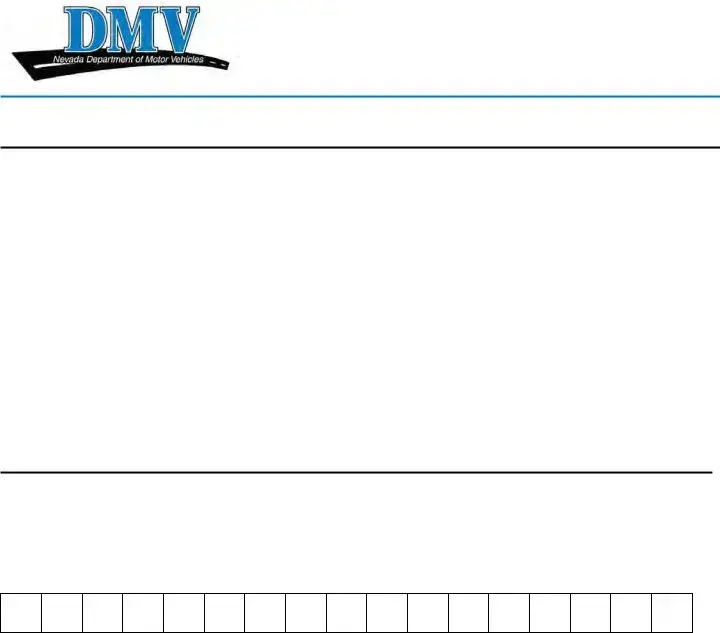555 WRIGHT WAY CARSON CITY, NV 89711-0700 Reno/Sparks/Carson City (775) 684-4DMV (4368) Las Vegas Area (702) 486-4DMV (4368)
Rural Nevada or Out of State (877) 368-7828 www.dmvnv.com
MOTORCYCLE HIGHWAY USE AFFIDAVIT NRS 482, 484, 486
By issuing a certificate of registration and/or certificate of title, the Nevada Department of Motor Vehicles does not certify, warranty, guarantee or in any way represent the described motorcycle as safe for operation upon the highway.
This form may be used for a registered owner and qualified licensed dealer or registered motorcycle repair shop to certify a 2-wheeled manufactured motorcycle not originally equipped or certified for use on public roads. The certification only applies to motorcycles that travel on two wheels with a seat designed to be straddled by the operator and with handlebar-type steering control. This includes all- terrain 2-wheeled motorcycles. Certification for on-road use of the following vehicle types will not be allowed: all-terrain vehicles, dune buggies, snowmobiles, trimobiles, mopeds, pocket bikes, motor vehicles registered by the Department, side-by-sides, utility vehicles, grey-market vehicles, non-road 3-wheeled vehicles and, as determined by the Department, any other vehicle that was not originally certified by the manufacturer for use on public roads.
Instructions
•Print clearly or type. A form that cannot be read will not be accepted.
•All parts of this form must be completed if the vehicle is not currently registered for use on road in Nevada.
•Only Part III of this form must be completed if the vehicle has been previously registered for use on road in Nevada and is being registered under new ownership.
•A Nevada licensed motorcycle dealer or Nevada registered motorcycle repair shop must complete Part I, if applicable.
•A Nevada DMV Agency Representative must complete Part II, if applicable.
•The vehicle registered owner must complete Part III and verify with a Nevada DMV Agency Representative or Notary Public.
•All inspection items must be checked “PASS,” indicating the item is present and in a safe operating condition before this motorcycle can be registered and/or titled, if applicable.
•OWNERSHIP DOCUMENTS (Title, MSO/MCO, Statement of Facts, Dealer Report of Sale, Secure Power of Attorney, etc.) MUST ACCOMPANY THIS FORM.
Important: If a Safety Inspection is required, a new form and inspection must be completed if any inspection items are marked
FAIL, not marked, improperly marked, or if corrections were made to the form.
Certification must be completed by a Nevada Licensed Motorcycle Dealer or Nevada Registered Motorcycle Repair Shop.
The work performed on the vehicle must meet the standards of the manufacturer for mechanical fitness and safety.
Year__________________Make_______________________Model_________________________
Vehicle Identification Number (VIN)
Check (√) Appropriate Boxes
|
PASS |
FAIL |
|
PASS |
FAIL |
|
PASS |
FAIL |
Horn |
|
|
Reflectors |
|
|
Brake Light |
|
|
Headlight(s) |
|
|
Taillight |
|
|
Fenders |
|
|
Turn Signals |
|
|
Muffler(s) |
|
|
Mirrors |
|
|
Frame |
|
|
DOT Legal Tires |
|
|
Brakes |
|
|
Before signing below, all items above must be marked “pass,” indicating the items are installed per NRS and in a safe operating condition.
Please Print Clearly or Type
Legal Business Name _________________________________________________________________
NameDMV Business License or Registration Number
Address__________________________________________________________________________________________
By signing this document, I understand I am accepting responsibility for certifying the described converted off-highway 2-wheeled motorcycle is mechanically safe to operate on Nevada public roads. This converted off-highway 2-wheeled motorcycle is equipped with all required devices necessary for safe operation upon the highway in accordance with all applicable NRS chapters and Federal requirements. I further certify that all safety devices have been installed in accordance with the applicable standards of the manufacturer and the motor vehicle repair industry.
_________________________________________ ___________________________________________ __________
Printed Full Legal Name of Affiant |
Signature and Position |
Date |
VP-254 (Rev 8/2012) |
Signatures must be originals. Photocopies are not acceptable. |
|
Changes may not be made to this form once it is signed and witnessed. |
|
PART II |
Completed by an Authorized Nevada DMV Representative |
VIN indicated in Part I Verified
VIN Inspection Fee
Odometer Reading (as shown on apparatus)
If the vehicle’s odometer apparatus only displays five numbers, please put an X in the first box.
1. The mileage stated is in excess of its mechanical limits.
2. The odometer reading is not the actual mileage. WARNING – ODOMETER DISCREPANCY
3. Exempt – Model year over 9 years old.
Additional comments:
________________________________ ______________________________ ______ __________
Printed Name of Nevada DMV Agency Representative |
Signature of Nevada DMV Agency Representative |
ID No. |
Date |
PART III Completed by Vehicle Owner & Verified by DMV Representative or Notary Public
The registered owner of the above-described converted off-highway 2-wheeled motorcycle hereby acknowledges, accepts and agrees that the original manufacturer does not certify the motorcycle for operation upon a public highway. However, the registered owner certifies the motorcycle has been modified for safe use upon Nevada public highways and meets all applicable safety and equipment requirements of Nevada Revised Statutes and Federal Law. The undersigned registered owner further acknowledges, accepts and agrees that the State of Nevada, Department of Motor Vehicles does not certify, warranty or guarantee or in any way represent the above-described motorcycle is safe for operation upon public highways. The undersigned registered owner of the above-described motorcycle hereby acknowledges, accepts and agrees the described motorcycle “is in a condition to be operated safely on the highways of this State,” and it is the registered owner’s responsibility to affirm the described motorcycle is, in fact, safe for operation upon Nevada public highways.
The undersigned registered owner of the described motorcycle certifies this motorcycle has been modified and the registered owner intends to operate it upon public highways in the State of Nevada. Furthermore, the registered owner wishes to have the vehicle registered and/or titled by the State of Nevada, DMV and does hereby expressly agree to indemnify, hold harmless and defend, not excluding the State’s right to participate, the State of Nevada, Department of Motor Vehicles, and its current and former employees, from and against all liabilities, claims, actions, damages, losses, and expenses, including, without limitation, reasonable attorney’s fees and costs, arising out of the operation of the described motorcycle after registration by the Nevada Department of Motor Vehicles. The undersigned registered owner of the described motorcycle also acknowledges the title of the motorcycle will have the brand of RECONSTRUCTED permanently attached to it.
Please Print Clearly or Type
_________ ______________________________________
YearMakeModel
Affiant’s Full Legal Name
(As appears on Drivers License)FirstMiddleLast
Affiant’s Physical Address
CityStateZip Code
Affiant’s Mailing Address
|
City |
State |
Zip Code |
State of Nevada, County of ____________________ |
|
|
Signed and sworn to before me on ______________ |
|
|
|
Date |
|
|
By _______________________________ |
|
|
Signature of Affiant |
________________________________________________ |
|
Notary Public or Authorized Nevada DMV Representative |
VP-254 (Rev 8/2012) |
Signatures must be originals. Photocopies are not acceptable. |
|
|
Changes may not be made to this form once it is signed and witnessed. |
|


